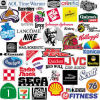 Merger mania is back. Today’s lunchtime news chum concerns some mergers that are in the news, as well as some other business news primarily focused on ways to bring in the green:
Merger mania is back. Today’s lunchtime news chum concerns some mergers that are in the news, as well as some other business news primarily focused on ways to bring in the green:
- If You See Your Waitress Here, Send Her Over With a Beer. The “mainstream” beer world is devolving, with everything distilling down to two major brewers who make most of the beer in the world (which personally isn’t a big deal for me, as I don’t drink beer). My favorite blog, Planet Money, has a wonderful thing they call a Beer Map: for any country, who makes the swill you drink (Two Giant Brewers, 210 Brands).
- A Clip Joint. So Office Depot and OfficeMax are merging. I don’t know if this is good or bad, but it probably isn’t that great for prices. Neither has ever been great in the fancy pen department. Of course, some cities are happy about it. Good example: St. Louis, which has no Staples stores, might get some to give Office MaxDepot some competition.
- An American Conglomeration. Tom Paxton once sung about the horrible baggage service of Republic Airlines. Republic was formed by the merger of North Central and Southern, and then merged with Hughes Airwest. This then merged with Northwest Orient to form Northwest, which then merged into Delta (which itself was the merger of Delta and Western). Then again, there is United Airlines, which is the merger of United and Continental, where Continental absorbed the old People Express and Texas International, and United absorbed most of Pan Am. Well these two Frankenstein monsters now have a third beast to contend with: American (which in the past had absorbed AirCal, Reno Air, and TWA) is merging with US Airways (which itself was the merger of Allegheny, Lake Central, Mohawk, Trump Shuttle, Piedmont, America West, US Airways, Pacific Southwest Airways) to form an even bigger American. Here’s how American and US Airways joined. I should note that coming up forth is the combination of Southwest and AirTran, which to my knowledge haven’t swallowed anything else.
And as we’re talking about business, here are a few more business related items to clear out the bookmarks:
- Flyaway Expanding… and Raising Fares. Yet another Flyaway bus line is being added to get people to LAX because the light rail doesn’t go there. This time, the bus will be running from the Expo Line La Brea Station starting in the Spring (at a price of $6, moving up to $7). More importantly to me, the article noted that one-way fares between Van Nuys bus terminal and LAX will rise to $8 July 2. The increase is expected to reduce an annual deficit of $531,000 for operating and maintaining the Van Nuys terminal to $168,000.
- Paying to Play. We’re all used to it. The hours and hours of previews before a movie. (That’s one nice thing about live theatre — no previews to sit through!). That may be changing, as a number of theatres are either charging to run the previews, or are limiting the number that can be run for free. I’m curious whether this means there will be less previews. The theatres need to be looking less for revenue and more for what will draw patrons in (as Michael Jonathan noted in a blog post I noted yesterday); their problem is that the movies they advertise might not even be running in their theatre, or certainly not exclusively in their theatre.
- In Bed With Martha Stewart. It appears Macys and Pennys are sparring over the queen of domestic advice, Martha Stewart. Yup, the two retailers are arguing over who has the sole right to see the convicted women’s branded stuff. Neither is asking, however, whether people actually care about the name in the first place.
- Customers Demand More Fees. Caesars Entertainment has announced that they are going to start charging resort fees in all of their Las Vegas properties. Specifically, Caesars will begin adding fees ranging from $10-$25 on March 1 that will provide package coverage for amenities including Wi-Fi, local calls and fitness centers. Caesars operates nine hotels in Las Vegas, including Caesars Palace, Harrah’s, Bally’s, the Flamingo, the Quad, Paris Las Vegas and Planet Hollywood on the Strip. Why are they doing this? According to Caesars, it is something guests asked for. Specifically, Caesars indicated guests asked for a pckage fee, as opposed to what Caesars did in the past: charging separately for such amenities.


 Saturday, while doing a daddy-daughter day, my daughter took me to her favorite used bookstore,
Saturday, while doing a daddy-daughter day, my daughter took me to her favorite used bookstore,  Today’s news chum brings a few stories related to travel:
Today’s news chum brings a few stories related to travel: Well, it’s Friday at lunch, and that means it is time to clean out the accumulated links that never quite formed into a theme:
Well, it’s Friday at lunch, and that means it is time to clean out the accumulated links that never quite formed into a theme: A number of news items in today’s lunchtime news reading address transportation in some form:
A number of news items in today’s lunchtime news reading address transportation in some form: Today’s lunchtime news chum brings together a collection of articles, all related to things that are up in the air:
Today’s lunchtime news chum brings together a collection of articles, all related to things that are up in the air: